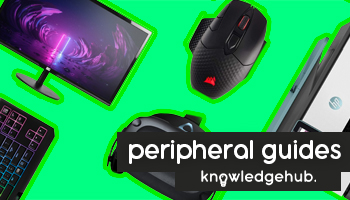In our Peripherals Buyers Guide we’ll talk you through what a peripheral is and some of the many different types of devices available. We’ll help you choose the right peripherals for your computer set-up. As well as all of the important internal stuff, you’ll need to make sure you purchase the right external devices so that you can enjoy a fully functional computer set-up which works well for you.
What exactly is a peripheral device?
A peripheral can be defined as a device which connects to a computer to increase its functionality. Peripherals have nothing to do with a computer’s memory or processing power, and instead exist outside of a computer’s core.
A peripheral can be many things; from a standard wired mouse to a gaming monitor or 3D printer. Peripherals are; input, output or storage devices. Examples including keyboards, webcams, printers, headphones and hard drives. Other terms used to describe peripheral devices include; an auxiliary component, external or integrated peripherals and an I/O device.
A key feature of a peripheral is its inability to work as a standalone device. In other words, a peripheral must be connected to something (e.g. a computer) to be able to operate correctly.
Peripheral devices explained
There are many different peripheral devices out there, with some rather weird inventions having been created over time (like a USB ghost radar, for example). Here, however, we’ll only be focusing on the stuff in more usual useas key peripherals.
Mice
If you want to navigate around your computer, you’re going to need a computer mouse. It’s an input device which detects movement it is forced into making on a surface, which is then translated to movement of a control cursor on a monitor or laptop screen.

You probably use a mouse every single day – but have you bought the correct one for your needs? There are a range of different designs available, with the most basic (and widely used) being the wired computer mouse.
Shop for peripherals at Ebuyer : Huge range to choose from
Wired and wireless mice
Most wired mice feature two buttons (left-click and right-click) and a scroll wheel in the centre too, to make it even easier to browse through your computer.
If you’d like to streamline your workspace, or you enjoy using a mouse with a laptop and frequently need to move around the office, you might prefer to go wireless instead. A wireless mouse is (as the name suggests) a peripheral which doesn’t need connecting to a computer or laptop via a wire. There are two main types: a regular wireless mouse, or a Bluetooth mouse.
Standard wireless mice use a radio frequency to connect. To sync everything up all you need to do is plug in the dongle that comes with the mouse to the correct port on your device. Bluetooth mice, on the other hand, will only work with a laptop or computer that has Bluetooth hardware installed. You simply need to connect to the mouse like you would with another Bluetooth device, and it’ll be ready to go.
Ergonomic mice
An ergonomic mouse is designed to offer added support for your wrist. Relieving muscle strain and helping you rest your hand in a more natural position, ergonomic mice can prevent RSI and other related wrist conditions.
Thanks to their ability to alleviate strain, they’re highly recommended for people who regularly work long hours in front of a computer.
Gaming mice
If you’re serious about gaming, it’s definitely worth investing in a gaming mouse. Every gaming mouse has been created to offer comfort, precision, faster response rates and a much wider range of customisation than a regular computer mouse.
There are hundreds of different options out there but, in general, gaming mice offer an improved shape and completely customisable buttons – all added to improve your performance. Additional features can be found across various models too, such as OLED screens, DPI switchers and vibrating motors.
Keyboards
Alongside a new mouse, you’re going to want a brand-new keyboard to complete your computer set-up. There are three main types: wired, wireless and specialist keyboards (such as gaming keyboards).
Wired and wireless keyboards
Most wired and wireless keyboards share the same standard layout, with QWERTY keys along the left-hand side and across the centre, numbers and navigation keys to the right and function buttons along the top. And, just like wired and wireless mice, they should be connected to your computer via a cable or using either Bluetooth or via radio frequency.
Of course, there are differences between each keyboard. When shopping for a new keyboard, consider price, design, how it feels to type on and the benefits of any additional extras (such as a fingerprint scanner or media buttons).
Gaming keyboards
Peripherals can make a serious difference when it comes to gaming. A good quality gaming keyboard is a must-have for many gamers – particularly those who enjoy first-person shooting games, strategy games and MMOs (massively multiplayer online games).
Gaming keyboards vary immensely in both design and features. Some have swappable keycaps, others have dual-layer macro keys, some offer statistic tracking and there are also the number of anti-ghosting keys and backlighting styles to consider. With all of these features to think about, you shouldn’t be afraid to browse for a while to find the gaming keyboard to suit you best.
You’ll find unique gaming keyboards from Corsair, Logitech, SteelSeries, Element Gaming and more available at Ebuyer here. View the collection today.

Printers
Printers are also classed as peripherals, and there are a handful of different types to consider. We’ve listed the most common below:
Inkjet printers
An inkjet printer works by placing tiny droplets of ink onto a piece of paper or card. The image or text you recreate on paper is essentially made up of thousands of dots so miniscule they’re hard to define individually.
Laser printers
Unlike inkjet printers, laser printers do not use liquid ink. Instead, laser beams inside the printer will scan repeatedly across a drum, producing static electricity in a particular pattern. Toner (a form of powdered ink) is attracted to the paper, and a fuser unit combines the toner and paper together.
All-in-one printers
All-in-one printers, as you may guess, are multifunctional peripherals. Whatever your AIO printer of choice, it’ll be able to copy, scan and print. Many all-in-one printers are capable of printing high-quality photographs too, and you’ll have the choice between a laser or inkjet style.
Photo printers
If your main priority when it comes to purchasing a printer is to be able to produce high-quality photographs, then there’s no doubt about it: you’re going to need a photo printer. Created by experts like HP, Canon and Epson, photo printers are designed to produce the best possible results. They’re often less bulky than regular printers too, and some are available in a portable design.

Mobile printers
If you need a printer which is easy to transport, opting for a mobile printer is the sensible choice. Ideal if you need to print documents when you’re travelling for work, or if you simply want a compact printer with a great performance that’s easy to move around, you can still expect high-quality performance from a mobile printer.
3D printers
3D printers are unlike any other printer, with the capability to create a physical object from a digital file. 3D printers works by creating successive layers of a particular material and laying them down together from the bottom up, until they stick together to form an object. It can be a very intricate process and can be exceptionally useful for product designers and engineers.
Wide format printers
Wide format printers are available in a range of different sizes, but they’re defined as printers which can support a print-roll between 18 and 100 inches wide. Anything that can support a print-roll of 101 inches or above is classed as a super-wide or grand format printer.
You may need a wide format printer if you need to regularly print high-quality posters, banners and artwork. Wide format printers can be particularly useful for creative industries.
Plotters
Plotters are renowned for being much more precise than regular printers, and are not really suitable for everyday use. Instead, plotters work through vector graphics, with a mechanical pen moving across paper to create a highly detailed hard copy of a design.
Ink and Toner
Inkjet printers require ink to print, whereas laser printers need toner. When the time comes to restock, you’ll have two options: buy a genuine product (ink or toner made by the manufacturer of the printer, such as HP) – or buy a generic product (ink or toner created by a different brand which has been designed to be compatible with your printer).
While generic inks and toners tend to be the cheapest option, genuine branded inks and toners do produce better results. Refined to work specifically with your computer, you’ll instantly see an improvement in quality, especially when printing photographs.
Scanners
You can create a digital copy of just about any document with a scanner; whether that’s a passport, meeting notes or a useful book page. There are two main scanner types: flatbed scanners and document scanners.
Flatbed scanners
Inside a flatbed scanner you’ll find a flat glass panel, on which you can lay a document or object, to prepare for scanning. The lid of a flatbed scanner is adjustable, so you can scan objects of varied thickness, from a single piece of paper or photograph to a book. You don’t need to move the object inside when scanning either, flatbed scanners will capture every detail automatically.
Document scanners
A document scanner is, as the name suggests, more suited to converting documents into a digital format. Ideal for office use, and helping massively with document management, document scanners are capable of sending the digital copy of the document directly to a specific computer or to an account which uses cloud storage.

Gaming controllers
Improve your level of in-game performance even further with a gaming controller. Gaming controllers vary from traditional console-style controllers and joysticks to specialised peripherals, such as gaming steering wheels and pedals. The type of game you play will influence which controller you need.
External hard drives
An external hard drive is a storage device which exists outside of a computer. Attach this peripheral via a USB port, and create a place to back up important files which you will be able to access anywhere, any time. Available in a range of sizes, from 500GB to 4TB or more, you’re sure to find one ‘big enough’ for your data storage needs.
External SSDs
An external SSD (solid state drive) is another type of storage device. Built with non-volatile flash memory, data is stored on memory chips which can store data even when there’s no power. They tend to be smaller and faster than external hard drives.
USB Flash drives
A USB Flash Drive is a small, portable storage device which connects to a computer or laptop via a USB port. Available in a range of sizes, from 2GB to 1TB or more, you’re sure to find one ‘big enough’ for your needs.
USB flash drives are also known as USB sticks. You’ll also find encrypted USB flash drives available, which are used to store private data. Password protection and other security features help keep your information safe, even if you lose your USB flash drive.
Peripherals by function
Some peripherals are simply suited to certain tasks better than others. Explore peripherals by their function below.
Shop for peripherals at Ebuyer : Huge range to choose from
Ergonomic peripherals
Office workers, or people who spend particularly long hours in front of a computer, may be at risk of developing an RSI (repetitive strain injury). RSI can occur as a result of repetitive tasks or poor posture, things that are all too common in the workplace. To prevent this from happening, ergonomic peripherals are recommended to anyone suffering from (or potentially at risk from) developing an RSI.
Ergonomic peripherals have been designed to purposely reduce pain in the shoulders, hands and wrists. Helping you to maintain a natural posture and offering a more comfortable experience, they’re certainly an investment worth making.
Peripherals for gamers
Gamers, your peripherals starting kit should always include three to four key things: a gaming mouse, a gaming keyboard, a gaming monitor and (if necessary for the type of games you like to play) a gaming controller.
As we’ve mentioned, every gamer’s needs will vary – so the perfect products for you are likely to be different to those suited to another gamer. Things to look out for include anti-ghosting features, N-key rollover and faster response buttons.
Peripherals for creatives
For those who work in a creative industry, additional peripherals can come in particularly useful. It all depends on your line of work as to which peripheral you might need, of course – but there’s a whole world of innovative peripherals to explore.
For instance, graphics tablets and 3D printers for designers and VR headsets for developers. You certainly won’t be limited, there’s much more to explore than just a standard mouse and keyboard – and each peripheral is designed to change the way you and your colleagues think and work.


